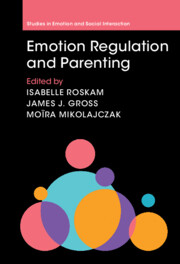Book contents
- Emotion Regulation and Parenting
- Studies in Emotion and Social Interaction
- Emotion Regulation and Parenting
- Copyright page
- Contents
- Figures
- Tables
- Contributors
- Preface
- Part I Conceptual Foundations
- Chapter 1 Parenting Science and Emotion Regulation: Principles, Effects, Determinants, and Supports
- Chapter 2 Emotion Regulation in Self and Others
- Part II Influence of Parents’ Emotion Regulation on Parenting
- Part III Influence of Parenting on Child Emotion Regulation
- Part IV Current Trends
- Index
- Studies in Emotion and Social Interaction
- References
Chapter 2 - Emotion Regulation in Self and Others
from Part I - Conceptual Foundations
Published online by Cambridge University Press: 05 January 2024
- Emotion Regulation and Parenting
- Studies in Emotion and Social Interaction
- Emotion Regulation and Parenting
- Copyright page
- Contents
- Figures
- Tables
- Contributors
- Preface
- Part I Conceptual Foundations
- Chapter 1 Parenting Science and Emotion Regulation: Principles, Effects, Determinants, and Supports
- Chapter 2 Emotion Regulation in Self and Others
- Part II Influence of Parents’ Emotion Regulation on Parenting
- Part III Influence of Parenting on Child Emotion Regulation
- Part IV Current Trends
- Index
- Studies in Emotion and Social Interaction
- References
Summary
This chapter provides an overview of emotion regulation, with a particular emphasis on topics relevant to parenting. We begin with a discussion of emotion generation and emotion regulation. Next, we present one of the most commonly used frameworks for studying emotion regulation – the process model of emotion regulation – with particular attention to how it can be applied to emotion regulation that takes place in interpersonal and familial contexts. We then provide a more in-depth overview of interpersonal emotion regulation. Finally, we briefly review key findings on emotion regulation from the developmental literature through the lens of the process model and discuss key directions for future research.
Keywords
- Type
- Chapter
- Information
- Emotion Regulation and Parenting , pp. 35 - 54Publisher: Cambridge University PressPrint publication year: 2023
References
- 1
- Cited by

